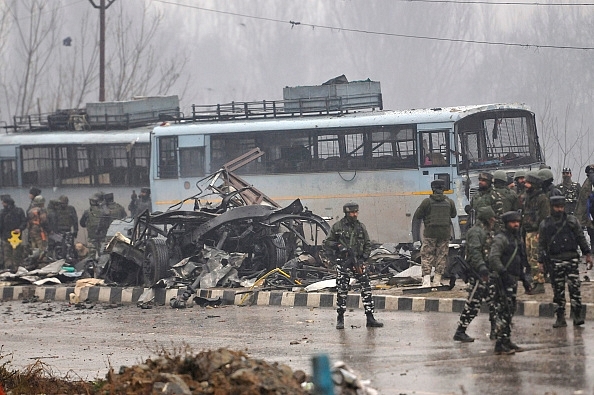Insta
Owner Of The Vehicle Used In Pulwama Terror Attack Among Two JeM Terrorists Killed In J&K’s Anantnag

The aftermath of the attack in Pulwama (Waseem Andrabi/Hindustan Times via Getty Images)
The security forces on Tuesday (18 June) gunned down two Jaish-e-Mohammad (JeM) terrorists, including one whose vehicle was used to carry out the blast in the Pulwama attack, in an encounter in Jammu and Kashmir’s Anantanag district, reports ANI.
"Two terrorists were killed and the bodies were retrieved from the site of encounter... As per the records available with police, both the killed terrorists were affiliated with proscribed terror outfit JeM and were wanted by law for their complicity in a series of terror crimes including attacking of security establishments and civilian atrocities," the J&K police said in a statement.
The encounter took place in Marhama village of Anantnag district in South Kashmir. According to the police, the slain terrorists, identified as Sajad Ahmad Bhat and Tawseef Ahmad Bhat, were both residents of Maharma and had links with JeM.
Sajad, according to the police records, was the owner of the vehicle which was used for carrying out the blast in Lethpora in Pulwama district killing 40 Central Reserve Police Force (CRPF) personnel.
"Sajad was wanted in Lethpora blast in which 40 CRPF personnel were martyred earlier this year. As per the material evidence collected during the course of the investigation, it was learnt that Maruti Eco vehicle used for carrying out the blast in Lethpora was owned by one Sajad Bhat of Marhama. As the news of Sajad's involvement spread, he escaped and joined proscribed terror outfit JeM," the police said, as reported by ANI.
As per the report, the police said that both the terrorists were involved in planning and executing a series of terror attacks.
Support Swarajya's 50 Ground Reports Project & Sponsor A Story
Every general election Swarajya does a 50 ground reports project.
Aimed only at serious readers and those who appreciate the nuances of political undercurrents, the project provides a sense of India's electoral landscape. As you know, these reports are produced after considerable investment of travel, time and effort on the ground.
This time too we've kicked off the project in style and have covered over 30 constituencies already. If you're someone who appreciates such work and have enjoyed our coverage please consider sponsoring a ground report for just Rs 2999 to Rs 19,999 - it goes a long way in helping us produce more quality reportage.
You can also back this project by becoming a subscriber for as little as Rs 999 - so do click on this links and choose a plan that suits you and back us.
Click below to contribute.
Latest